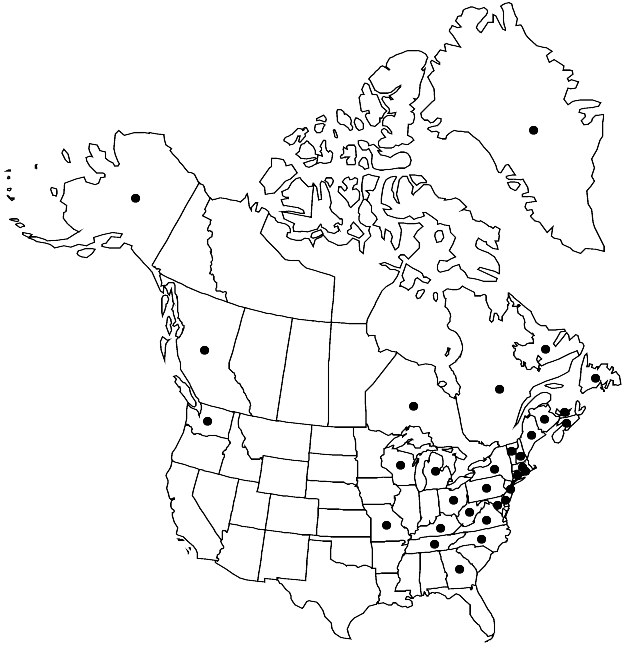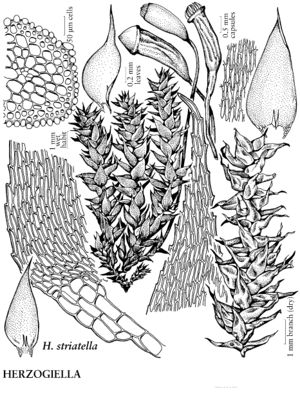Difference between revisions of "Herzogiella striatella"
J. Hattori Bot. Lab. 33: 374. 1970.
FNA>Volume Importer |
imported>Volume Importer |
||
| (6 intermediate revisions by 2 users not shown) | |||
| Line 9: | Line 9: | ||
|special_status={{Treatment/ID/Special_status | |special_status={{Treatment/ID/Special_status | ||
|code=F | |code=F | ||
| − | |label= | + | |label=Illustrated |
}} | }} | ||
| − | |basionyms={{Treatment/ID/ | + | |basionyms={{Treatment/ID/Basionym |
|name=Leskea striatella | |name=Leskea striatella | ||
|authority=Bridel | |authority=Bridel | ||
| + | |rank=species | ||
| + | |publication_title=Bryol. Univ. | ||
| + | |publication_place=2: 762. 1827 | ||
}} | }} | ||
|synonyms={{Treatment/ID/Synonym | |synonyms={{Treatment/ID/Synonym | ||
|name=Dolichotheca striatella | |name=Dolichotheca striatella | ||
|authority=(Bridel) Loeske | |authority=(Bridel) Loeske | ||
| − | }}{{Treatment/ID/Synonym | + | |rank=species |
| + | }} {{Treatment/ID/Synonym | ||
|name=Herzogiella fitzgeraldii | |name=Herzogiella fitzgeraldii | ||
|authority=Lesquereux & James | |authority=Lesquereux & James | ||
| − | }}{{Treatment/ID/Synonym | + | |rank=species |
| + | }} {{Treatment/ID/Synonym | ||
|name=H. muehlenbeckii | |name=H. muehlenbeckii | ||
|authority=C. Hartman | |authority=C. Hartman | ||
| − | }}{{Treatment/ID/Synonym | + | |rank=species |
| + | }} {{Treatment/ID/Synonym | ||
|name=Isopterygium striatellum | |name=Isopterygium striatellum | ||
|authority=(Bridel) Loeske | |authority=(Bridel) Loeske | ||
| − | }}{{Treatment/ID/Synonym | + | |rank=species |
| + | }} {{Treatment/ID/Synonym | ||
|name=Plagiothecium muehlenbeckii | |name=Plagiothecium muehlenbeckii | ||
|authority=Schimper | |authority=Schimper | ||
| − | }}{{Treatment/ID/Synonym | + | |rank=species |
| + | }} {{Treatment/ID/Synonym | ||
|name=P. striatellum | |name=P. striatellum | ||
|authority=(Bridel) Lindberg | |authority=(Bridel) Lindberg | ||
| − | }}{{Treatment/ID/Synonym | + | |rank=species |
| + | }} {{Treatment/ID/Synonym | ||
|name=Sharpiella striatella | |name=Sharpiella striatella | ||
|authority=(Bridel) Z. Iwatsuki | |authority=(Bridel) Z. Iwatsuki | ||
| + | |rank=species | ||
}} | }} | ||
|hierarchy=Hypnaceae;Herzogiella;Herzogiella striatella | |hierarchy=Hypnaceae;Herzogiella;Herzogiella striatella | ||
| Line 51: | Line 61: | ||
|elevation=low to high elevations (0-2000 m) | |elevation=low to high elevations (0-2000 m) | ||
|distribution=Greenland;B.C.;N.B.;Nfld. and Labr.;N.S.;Ont.;P.E.I.;Que.;Alaska;Conn.;Del.;Ga.;Ky.;Maine;Md.;Mass.;Mich.;Mo.;N.H.;N.J.;N.Y.;N.C.;Ohio;Pa.;R.I.;Tenn.;Vt.;Va.;Wash.;W.Va.;Wis.;Europe;Asia. | |distribution=Greenland;B.C.;N.B.;Nfld. and Labr.;N.S.;Ont.;P.E.I.;Que.;Alaska;Conn.;Del.;Ga.;Ky.;Maine;Md.;Mass.;Mich.;Mo.;N.H.;N.J.;N.Y.;N.C.;Ohio;Pa.;R.I.;Tenn.;Vt.;Va.;Wash.;W.Va.;Wis.;Europe;Asia. | ||
| − | |discussion=<p>Herzogiella striatella is recognized by its close, squarrose to squarrose-recurved leaves with 2–4 rows of abruptly inflated, hyaline or orange to red, decurrent cells extending 4–6 cells down the stem. This species has a disjunct distribution in North America, occurring commonly in the eastern third of the continent and more rarely in the western part in British Columbia, Alaska, and Washington. Herzogiella striatella may have a closer relationship to H. cylindricarpa (Cardot) Z. Iwatsuki of Mexico, Central America, South America, and Africa than to other North American species, as revealed by a study of spore ornamentation (R. R. Ireland 1990). The report for Alabama by Ireland (1991b) is an error.</p> | + | |discussion=<p><i>Herzogiella striatella</i> is recognized by its close, squarrose to squarrose-recurved leaves with 2–4 rows of abruptly inflated, hyaline or orange to red, decurrent cells extending 4–6 cells down the stem. This species has a disjunct distribution in North America, occurring commonly in the eastern third of the continent and more rarely in the western part in British Columbia, Alaska, and Washington. <i>Herzogiella striatella</i> may have a closer relationship to H. cylindricarpa (Cardot) Z. Iwatsuki of Mexico, Central America, South America, and Africa than to other North American species, as revealed by a study of spore ornamentation (R. R. Ireland 1990). The report for Alabama by Ireland (1991b) is an error.</p> |
|tables= | |tables= | ||
|references= | |references= | ||
| Line 60: | Line 70: | ||
-->{{#Taxon: | -->{{#Taxon: | ||
name=Herzogiella striatella | name=Herzogiella striatella | ||
| − | |||
|authority=(Bridel) Z. Iwatsuki | |authority=(Bridel) Z. Iwatsuki | ||
|rank=species | |rank=species | ||
| Line 74: | Line 83: | ||
|publication title=J. Hattori Bot. Lab. | |publication title=J. Hattori Bot. Lab. | ||
|publication year=1970 | |publication year=1970 | ||
| − | |special status= | + | |special status=Illustrated |
| − | |source xml=https:// | + | |source xml=https://bitbucket.org/aafc-mbb/fna-data-curation/src/2e0870ddd59836b60bcf96646a41e87ea5a5943a/coarse_grained_fna_xml/V28/V28_816.xml |
|genus=Herzogiella | |genus=Herzogiella | ||
|species=Herzogiella striatella | |species=Herzogiella striatella | ||
Latest revision as of 21:38, 5 November 2020
Plants in thin to dense mats, yellowish, dark green, or brownish. Stems 2 cm, 0.5–2 mm wide, ascending to erect. Leaves loosely imbricate to somewhat spreading, often squarrose, sometimes squarrose-recurved, usually straight at stem and branch apices, not plicate, 0.6–2 × 0.3–0.8 mm; base distinctly decurrent; margins serrulate to strongly serrate; alar cells rounded to oval, abruptly inflated, 14–65 × 14–24 µm, hyaline, sometimes orange to red; basal laminal cell walls pitted, sometimes pitted to mid leaf or beyond; medial cells 24–50 × 4–7 µm. Sexual condition autoicous. Seta light brown to red, 0.9–2 cm. Capsule inclined to nearly erect, light brown, oblong to cylindric, slightly arcuate to straight, 1–2 × 0.3–0.5 mm, not or little contracted below mouth when dry; operculum conic to conic-apiculate, 0.3–0.4 mm. Spores 10–15 µm.
Phenology: Capsules mature summer.
Habitat: Shaded soil and humus, acidic cliffs and rock, rotten logs, stumps, base of trees, exposed tree roots
Elevation: low to high elevations (0-2000 m)
Distribution

Greenland, B.C., N.B., Nfld. and Labr., N.S., Ont., P.E.I., Que., Alaska, Conn., Del., Ga., Ky., Maine, Md., Mass., Mich., Mo., N.H., N.J., N.Y., N.C., Ohio, Pa., R.I., Tenn., Vt., Va., Wash., W.Va., Wis., Europe, Asia.
Discussion
Herzogiella striatella is recognized by its close, squarrose to squarrose-recurved leaves with 2–4 rows of abruptly inflated, hyaline or orange to red, decurrent cells extending 4–6 cells down the stem. This species has a disjunct distribution in North America, occurring commonly in the eastern third of the continent and more rarely in the western part in British Columbia, Alaska, and Washington. Herzogiella striatella may have a closer relationship to H. cylindricarpa (Cardot) Z. Iwatsuki of Mexico, Central America, South America, and Africa than to other North American species, as revealed by a study of spore ornamentation (R. R. Ireland 1990). The report for Alabama by Ireland (1991b) is an error.
Selected References
None.
